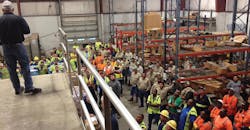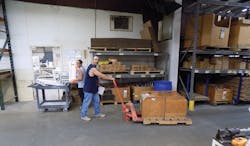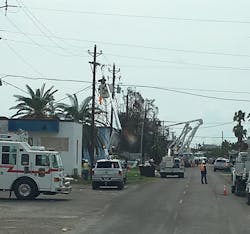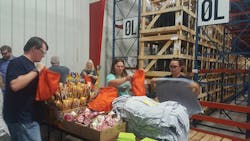The 2017 hurricane season will probably go down in history as one of the most destructive and expensive hurricane seasons in history. In addition, it will go down as one of the biggest restoration efforts performed by the electric power delivery industry in history. Power grids along the Gulf Coast and the East Coast of the U.S. were hard hit by winds, rain and flooding. In the Caribbean, it was worse as the infrastructure on several islands was destroyed and the power grids were completely wiped out.
Estimates for restoring electric power have reached nightmare proportions throughout the devastated areas. It is estimated rebuilding will take months, if not years.
On the mainland, convoys from utilities around North America hit the highway after loading all the supplies heavy-duty utility vehicles could carry. In the Caribbean, airlifts and shiploads of material began moving, and the slow process of rebuilding started.
The condition of the storm damaged areas was assessed and resources were sent to the region. Work on the region damaged by Hurricane Harvey is fully under way, and the Hurricane Irma rebuild is moving forward. Hurricane Maria restoration is proceeding slowly. At the height of the restoration effort, more than 60,000 workers from more than 250 investor-owned electric utilities and electric cooperatives assembled to help. These workers included line crews, engineers, technicians, tree trimmers and other support personnel.
Front Line
Electric utilities in regions hard hit by the hurricanes activated their mutual assistance network, but boots on the ground require tremendous logistical support. Keeping these frontline troops supplied with the necessary hardware and equipment requires a huge effort on the part of manufacturers, vendors and suppliers. These companies make up the supply chain the electric utility industry depends on for day-to-day support, but the supply chain shifts to a more intense structure when disaster strikes. They understand restoration efforts require equipment and materials be delivered to staging areas daily. It is a nonstop effort to keep the crews well stocked and not waiting on parts.
To keep the work flowing, manufacturers and vendors stepped up their efforts in getting supplies to the front line. Without crossarms, poles, transformers, fuse links, splices, insulators, conductor, connectors and the thousands of other items essential to supplying power to customers, the restoration process would be impossible. The 60,000-plus utility personnel working in the field were the tip of the iceberg. They were supported by a huge network of people producing, packaging, shipping and delivering all the nuts and bolts needed to rebuild the damaged grid.
Speed of response is everything after a storm hits the grid, according to Eaton’s Cooper Power Systems LLC. This is the reason why Cooper monitors every hurricane and tracks outages in the hurricane-devastated areas. This monitoring is critical to the company’s Storm Boss, who gives hourly reports to all response teams. Storm alerts are rated yellow, orange or red, and are updated continuously. Using this information, the teams quickly ramp up operations for restoration materials used during storm recovery. This information is essential for the teams to expedite production and shipping for the resources required for immediate storm restoration efforts.
Ramping Up Support
Border States Electric (BSE) has been working with manufacturers to keep supply disruptions to a minimum for short-term power restoration and long-term rebuilding efforts. BSE maintains a $2 million storm inventory that includes cross-arms, poles and insulators. According to the supply chain solutions company, GE reported one of its circuit breaker plants in Puerto Rico was impacted by Hurricane Maria. BSE also noted Okonite added capacity in 2017 that would help with the demand for medium-voltage cable needed in the rebuild effort. In addition, the company monitored other distribution equipment suppliers to stay on top of the resupply effort.
A DIS-TRAN packaged substations team monitored the storms, utilities and sub-suppliers across the country to support the restoration effort in storm-ravaged regions. The company’s goal was to keep projects moving forward and ensure there were no logistical headaches to their customers.
Utilities use a great deal of material to get their systems operational after being damaged by a storm. Mike Edmonds, president of S&C Electric Co.’s U.S. business unit, said, “S&C has a long history of working hand in hand with our customers during major weather events. Before the hurricanes reached land, S&C began ramping up production for such essentials as fuse links, pad-mounted switches and switchgear. We have prioritized the delivery of this equipment.
“Factory personnel are working 24/7 to produce all the essential equipment needed to get the grid affected by the hurricanes back in full operation,” Edmonds added. “At the same time, commercial teams organized, scheduled and prioritized the delivery of the equipment to support the utilities’ needs efficiently.”
In the first few weeks of restoration, S&C had produced 95,000 fuse links, 35 units of padmounted switchgear and 15 motor operators to assist impacted utilities. “S&C made a $55,000 contribution to the American Red Cross to aid in the overall relief effort,” Edmunds said.
High winds and falling trees took a toll on overhead distribution lines and their supporting structures. Many suppliers such as Hughes Brothers Inc., Falcon Steel America, Valmont Industries Inc., DIS-TRAN, Laminated Wood Systems Inc., Trinity Meyer Utility Structures LLC, Sabre-FWT, Eaton and others met the challenge of the rebuilding effort.
Siemens Corp. mobilized its sales and consulting engineers, service technicians and service departments in the hurricane-damaged areas. These groups were on-site to provide support in assessing electrical systems. The company also helped utilities to establish efficient recovery plans, where needed. According to Siemens, all of its production plants across the country had dedicated capacity to respond to hurricane restoration projects. Siemens used local distribution by stocking its warehouses to full capacity with the necessary distribution equipment.
Likewise, GE’s emergency-response teams supported utility customers impacted by the hurricanes. In addition to providing T&D equipment, GE’s field service engineers helped utilities to evaluate and repair hurricane-damaged electrical equipment. The company also contributed $500,000 to the American Red Cross and pledged to match the donations its employees made to disaster-relief organizations.
More Than Material
There were several cases where the hurricanes impacted those supporting the restoration effort, too. The Doble Engineering Co.’s Houston, Texas, laboratory was temporarily closed because of Hurricane Harvey and the damage it inflicted on the region. Doble notified customers its employees were safe and the lab would be reopened as soon as possible. The company asked customers to use its other labs. Each lab is part of the Doble network and had access to all customer records because of the computer system’s data-sharing abilities. Until the Houston operation was reopened, Doble’s other labs were available to close ranks and support customers’ rebuilding efforts to restore power.
It also was personal for ABB. The company has factories and other facilities in the storm-damaged regions, and many of its employees and their families needed support. ABB helped employees and affected communities in Florida, Texas and Louisiana by partnering with the American Red Cross to ensure swift emergency aid for the victims of Irma and Harvey. ABB is matching employees’ donations dollar for dollar.
In addition, “ABB mobilized service teams from all over the U.S. as well as Canada, Mexico and other countries to help our customers return to operations as quickly and as safely as possible,” said Greg Scheu, president of ABB Americas.
Scheu also noted ABB factories had ramped up supplemental inventories and teams of service experts. In addition, the company manned a disaster customer service center to assist its utility and industrial customers with damage assessment as well as to coordinate the correct response.
When thinking about storm restoration support from manufacturers, the typical response is supplying equipment and materials quickly, but Falcon Steel went beyond the typical concept. The company has a 226,000-sq-foot lattice manufacturing and galvanizing facility in Conroe, Texas. It had been spared by Harvey and the flooding. The company reached out to authorities with a different type of offer. Falcon Steel allowed the U.S. Department of Homeland Security, FEMA, American Red Cross, U.S. Coast Guard, Montgomery County and City of Conroe emergency management officials to use the facility in whatever manner they felt would benefit the community best.
“Within 36 hours, our phones were burning up with calls for requests to utilize the facility,” said James Taylor, president and CEO of Falcon Steel. “Within five hours from the first request, our Falcon Steel America Conroe warehouse had opened and become a critical and major location for Montgomery County donations coming in from across the country. Tens of thousands of donations were being received, sorted and housed on a daily basis to be distributed to shelters for flood evacuees and others who endured damage during this historic storm.
“Falcon Steel America was also asked if [the company] could house first responders coming in from across the country to participate in the search and rescue efforts,” Taylor said. “We stocked our breakroom shelves and refrigerators, and purchased additional coffee pots that day, and then opened our front-office building space to allow these dedicated men and women to have a place to rest, wash up, relax, eat and sleep before their shift would start all over again.”
The Personal Touch
Restoration after storms also requires a great deal of conductor and cable to rebuild distribution circuits and transmission lines. This is an area where Southwire has a lot of experience. Southwire keeps an inventory of wire and cable for storm recovery in its factories to be ready when disasters occur. Southwire’s storm specialists monitored hurricanes Harvey, Irma and Maria and worked closely with the utilities in the path of the storms. Once it was determined where the storms would hit land, Southwire prioritized production space and began producing wire and cable for the restoration effort.
Not only were Southwire employees busy keeping four factories running 24/7, producing wire and cable to fulfill storm-related orders, they also found time to take part in Project GIFT. According to Southwire, “Project GIFT began as an outlet to serve those suffering in the wake of disaster, and we continue to focus our efforts in that same spirit of giving back.”
Southwire gathered emergency supplies — bottled water, paper goods, cleaning supplies, nonperishable food, baby items, pet supplies, personal hygiene products, ice chests and other items — for victims of Harvey and Irma. As a result, the company filled more than 22 semi-trucks for its Project Gift.
Utility One Source’s support for the restoration efforts took a personal turn. The company planned to exhibit at the ICUEE expo on Oct. 3-5 in Louisville, Kentucky. When the hurricanes hit, Utility One Source received many requests for equipment to support the restoration effort. The company opted to send several units scheduled to be at ICUEE to those who needed the equipment for restoration efforts. Utility One Source also sent supplies, cases of water and food to its Houston company, Custom Truck & Equipment, for the staff to distribute. In addition to supplies, the company sent three boats and four amphibious vehicles to help aid in the relief efforts.
Many requests for help are real emergencies and time is limited. During the restoration effort, Hastings Hot Line Tools & Equipment in Hastings, Michigan, received an emergency order from a Texas distributor at 11:30 a.m. The distributor needed four sets of custom-made grounds and a live-line tester shotgun stick to install the grounds, and the order had to be completed and shipped to Texas by 1 p.m. for arrival that same day.
Hastings fulfilled the order on time, even with multiple changes to the order in the 90-minute window. The company pulled people from different departments to do whatever it took to make it all happen. The customer was so grateful it had pizzas delivered to all involved with the order.
Reaching Out
Hubbell Power Systems Inc. knew restoration would be challenging. Hurricanes Harvey, Irma and Maria were powerful storms. The company started receiving orders two days in advance of Harvey’s landfall and it never let up. Hubbell was prepared as it has a dedicated Hubbell emergency action team (HEAT) that specializes in storm response and is always ready to act quickly. Over the next three weeks, Hubbell shipped 1 million pounds of utility products in response to Harvey.
When a customer ordered an item not in stock, its manufacturing facilities rose to the challenge. One example was immediately producing more than 500 cutouts for a Texas utility and shipping them directly to Houston to keep things rolling.
In addition to all the material, equipment and tools, Hubbell employees donated approximately 500 storm packs for utilities in Texas. The packs included two bottles of water, a towel, a T-shirt, snacks and a handwritten card. The packs were shipped to Texas with the product shipments for delivery. When Irma hit, Hubbell prepared another 500 storm packs for utilities in Florida and Georgia and sent them with the storm shipments of arresters, insulators, cutouts, pole line hardware, tools, grounding equipment, gloves, connectors and more.
When substations drown, the control and protection equipment really suffers. Before anyone can re-energize the circuits coming out of them, the protection and control systems must be operational. Schweitzer Engineering Laboratories (SEL) stepped up to help its utility customers in a big way after the devastation of Harvey and Irma. Hundreds of its employees volunteered to work overtime on the weekends to ramp up production rates. In addition, more than 100 employees changed their Labor Day weekend plans to go into work to help get the lights back on in the stricken areas.
Initially, SEL shipped 525 products to 28 customers in the hurricane-impacted areas. SEL also expedited all shipping, with more than 75% of its orders shipping within 24 hours. In addition, SEL offered a disaster discount of 25% on all products bound for the affected areas. This disaster discount has a long history with SEL that goes back to the Mississippi River flood of 1993. There also was the personal touch of caring. The employees and SEL President Edmund Schweitzer donated more than $300,000 to hurricane relief funds.
Rebuilding
This has been a hurricane season for the record books with several Category 4 hurricanes and two Category 5 hurricanes. Islands were wiped out, major metropolitan areas were flooded and the grid was damaged beyond what anyone expected, but there also have been restoration efforts for the record books. Armies of responders throughout North America answered the call for help in regions devastated by the storms. Where the electric delivery system had been damaged heavily, these frontline troops began the process of restoration.
While workers were risking their lives, another army of suppliers — vendors and manufacturers — worked around the clock to keep the supplies of equipment, hardware, conductors and other material flowing into the storm-ravaged areas.
The electric industry knows how important getting the power back on is to the community. It is more than a job for those in the industry, it is in their DNA. Loss of electricity rips the fabric of society and yanks the lifeline on which so many depend. From every corner of the industry, everyone worked together to bring back electricity and, with it, society’s sense of normalcy and security. This was an epic rebuild in every sense of the word. It reflected a partnership among utilities, contractors and vendors that developed over many past storm-restoration efforts. There are plenty of lessons learned that will be applied to future storms to respond even quicker. ♦
About the Author
Gene Wolf
Technical Editor
Gene Wolf has been designing and building substations and other high technology facilities for over 32 years. He received his BSEE from Wichita State University. He received his MSEE from New Mexico State University. He is a registered professional engineer in the states of California and New Mexico. He started his career as a substation engineer for Kansas Gas and Electric, retired as the Principal Engineer of Stations for Public Service Company of New Mexico recently, and founded Lone Wolf Engineering, LLC an engineering consulting company.
Gene is widely recognized as a technical leader in the electric power industry. Gene is a fellow of the IEEE. He is the former Chairman of the IEEE PES T&D Committee. He has held the position of the Chairman of the HVDC & FACTS Subcommittee and membership in many T&D working groups. Gene is also active in renewable energy. He sponsored the formation of the “Integration of Renewable Energy into the Transmission & Distribution Grids” subcommittee and the “Intelligent Grid Transmission and Distribution” subcommittee within the Transmission and Distribution committee.




